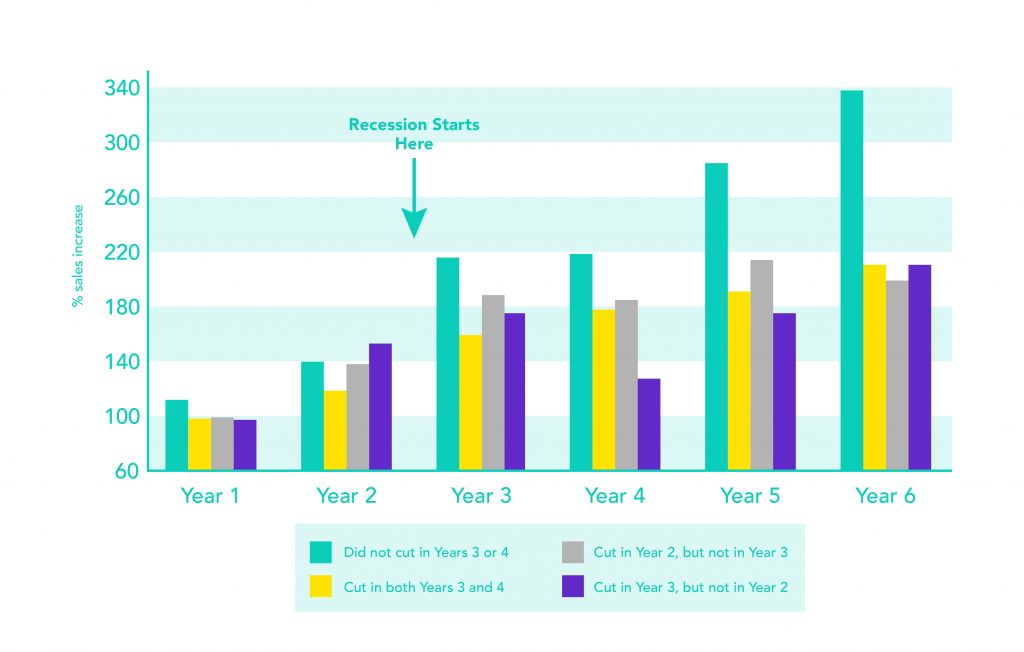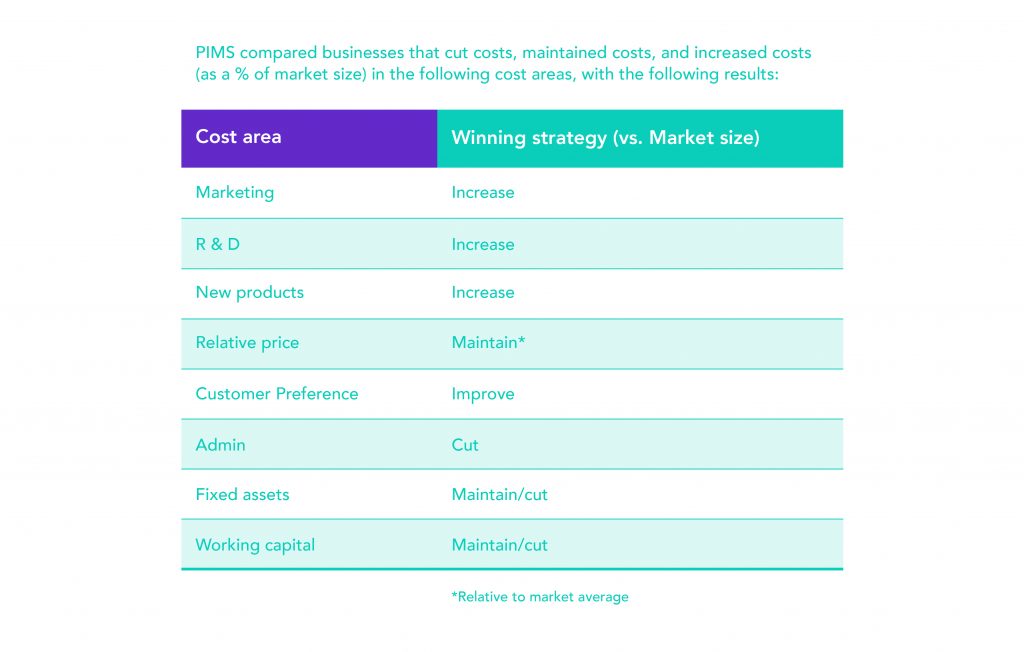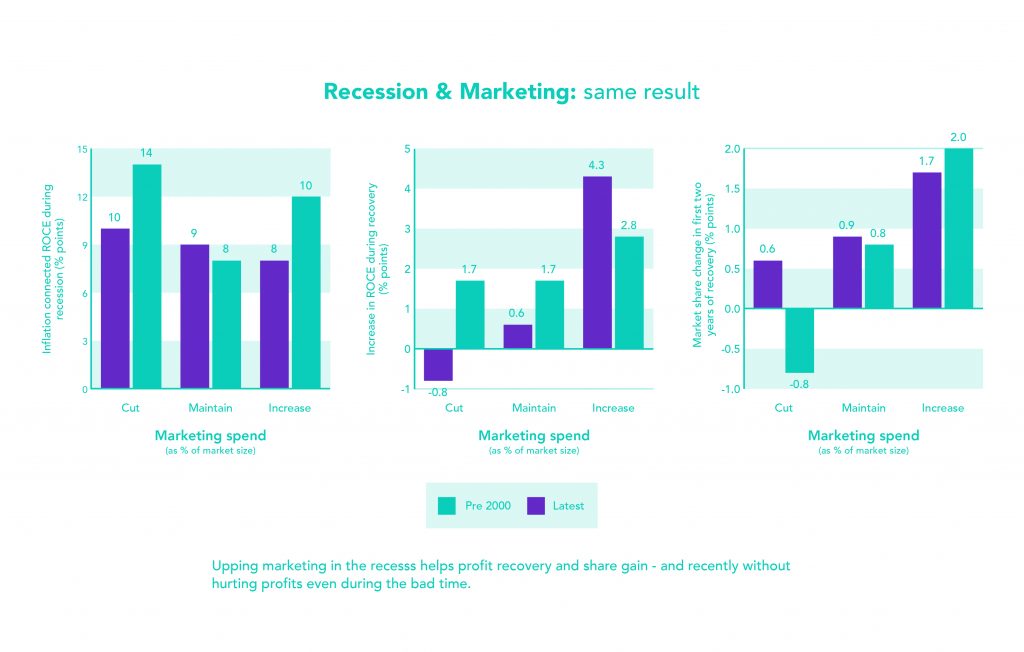
Marketing during a downturn
The effects of COVID-19 are being felt across the globe and as leaders it’s our responsibility to do what we can to protect our families, our communities, and our businesses.
It’s not just about surviving this storm, but to come out thriving. The impact of the decisions we make today, tomorrow, and over the coming weeks, are going to be felt for years to come.
In any market downturn, the typical knee-jerk reaction is for businesses to hoard cash by cutting variable costs as quickly as possible. Whilst this feels like a natural survival response, the impact this can have on the medium to long-term can be devastating.
To give some context, we have explored historical data to analyse the impact on reducing marketing spend during economic downturns.
Summary of findings
Cutting budgets in a downturn will only help defend profits in the very short-term.
Ultimately, the business will emerge from the downturn weaker and much less profitable.
It is better to maintain SOV (share of voice) at or above SOM (share of market) during a downturn: the longer-term improvement in profitability is likely to greatly outweigh the short-term reduction.
If other businesses are cutting budgets the longer-term benefit of maintaining SOV at or above SOM will be even greater.
Marketing during Coronavirus
Look for opportunities to reduce fixed costs. Free up the budget to continue / enhance marketing efforts.
Given current conditions, pull budget from out of home campaigns / events / print (unless B2C) into online.
The current conditions may bring a new audience to your business. Think about how you market and communicate with them.
Use this time to push through larger scale changes or requests you’ve been postponing.
Accept that conversion rates may be lower during this period, but this will be countered by lower media buying costs.
Use this time to increase brand awareness and loyalty at much lower costs and consider how you market and add value to existing clients.
Use this opportunity to track prospects on cookie lists and build a prospect list at much lower costs.
Don’t default to “coronavirus” price discounts. This is a short-term play that will only eat into your profits in the long-term.
McGraw-Hill Research. Laboratory of Advertising Performance Report, 1986
Between 1980 and 1985, McGraw-Hill analysed 600 companies in 16 different sectors.
The research and subsequent results showed that companies increasing or maintaining advertising spend during the 1981-1982 recession enjoyed higher sales growth throughout both the recession and the years afterwards. By the end of the research in 1985, companies that kept up their advertising saw a sales increase of 256% over companies that cut advertising (FIG. 1).
FIG. 1

The Institute of Practitioners in Advertising Report, 2008
Malik PIMS
PIMS analysed data collected from around 1,000 business units in developed economies during periods of market downturn and subsequent market recovery. Their data is extremely robust, highly respected, and enables a comparison of downturns from pre-2000 with more recent ones.
Whilst maintaining or reducing fixed costs was desirable, the opposite was true of marketing costs. Communications, R&D and new product development were all areas where increased spend correlated with business success during downturns. By improving customer preference and enabling maintained relative price, increasing marketing spend drove success.
The report further detailed the impact of cutting or halving advertising spend in the long-term (FIG. 2).
The first of these charts looked at marketing spend, and shows that ROCE (return on capital employed) and market share after the downturn were considerably better by increasing marketing costs during the downturn.
The results show that whilst ROCE during the downturn may have been mildly adversely affected by increased marketing spend, it wasn’t significant. Plus, the longer-term upside greatly exceeded any short-term downside. By contrast, cutting marketing costs resulted in less ROCE recovery and reduced market share post-downturn. This pattern of more recent findings is, therefore, broadly the same as was found with the earlier data.
FIG. 2

The PIMS analysis provides clear evidence that increasing marketing communications spend in a downturn is a profitable strategy for recovery.
Why? Because media costs and competitor activity tend to fall. This means that a downturn provides a window of opportunity for gaining cheap market share, for businesses increasing investment.
It’s also worth noting that increased spend on R&D brings similar benefits, whilst upping NPD (new product development) is the best strategy for enhancing short-term ROCE during the downturn. However, this brings little benefit thereafter.
Data2Decisions Report
Data2Decisions, an econometric modelling consultancy, produced a report looking at the business impact of budget cutting during a downturn. They highlight a key consideration – the time-lag effect.
Evidence shows that although most estimates of short-term payback from advertising was around 50%, the payback over the longer term (one to four years in this example) was often considerably greater.
A case study shows the long-term payback was over four times greater than the short-term. It also highlights that brands cutting marketing spend will often witness misleading short-term profitability – the longer-term business harm will be more considerable, but is unlikely to be noticed at first.
The long-term effects of two different budget-cutting scenarios were modelled for the business. In the first scenario, the budget was cut to zero for just one year and then returned to usual levels. In the second scenario, the budget was halved for one year and then returned to usual levels. Sales recovery to pre-cut levels took five and three years respectively, with cumulative negative impacts on the bottom line of £1.7m & £0.8m (FIG. 3).
FIG. 3

Other dangers of common downturn behaviours were also identified. The diversion of marketing spend into price promotions is a common response to downturn. However, consumers quickly come to expect ‘incentives’. They lose their efficiency as a generator of incremental sales and end up losing profitability.
A widely overlooked impact of reduced brand marketing is price elasticity. The abandonment of marketing is likely to result in the gradual increase in price elasticity and the growing need to reduce pricing to maintain volume. This may have a very damaging impact on profitability, but again one that is deceptively time-lagged.
Final comments
These are undoubtedly challenging times filled with uncertainty. The important thing to remember is that we will get through this.
However, when we reach the other side, will your business be a shell of its former self, or will it have made strides forward, primed for growth and success?
Opting to pause marketing budgets should be the very last resort. As highlighted by the studies in this post, it will jeopardise long-term prosperity.
This is not the time to panic.
This is the time for businesses to double down.
This is the time to be greedy while others are fearful.
Sources:
Sign-up to Reddico News
To keep up-to-date with the latest developments in the world of SEO, our insights, industry case studies and company news, sign-up here.




